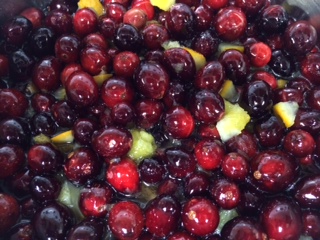
by Ginny Hinton | Nov 15, 2018

Cranberries cooking
It may seem like the year has barely started, but the holiday season is here! A little bit of planning now can go a long way toward avoiding that, “I blew my diet and need bigger jeans” feeling. Believe it or not, there are holiday treats that are nutritionally guilt-free, as long as you don’t go overboard. As with so many other things, moderation is the key! Below are some classic holiday favorite foods with hidden health benefits:
Sweet Potatoes: It’s no secret that sweet potatoes are good for you – but they may have even more benefits than you think! Sweet potatoes contain a lot of Vitamin A. That’s a great source of alpha and beta carotene that helps keep your eyes, bones and immune system in top shape. Sweet potatoes are also one of the top food sources of potassium, with almost twice as much of the mineral as you find in a banana. When choosing sweet potatoes, look for ones that are firm with tapered ends and a uniform shape and color. Miniature sweet potatoes are fun and pack the same great health benefits.
Cranberries: Bright red cranberries are a little too tart to eat alone but they add a beautiful festive touch to any holiday table. With only 45 calories per cup plus a healthy dose of Vitamin C and fiber, they’re a winner all the way around. Cranberries also have more disease-fighting antioxidants than almost every other fruit and vegetable. Buy cranberries fresh in the fall and winter and use them soon, as they don’t last long. Store them in a tightly sealed bag in your refrigerator to keep them fresh longer.
Nuts: Yes, they’re high in calories – and fat – but nuts are also loaded with vitamins and minerals. Eating a handful of nuts a few times a week may lower your risk of heart disease. Nuts are full of antioxidants, energy and protein. Think of nuts, in moderation, as a Christmas gift for your body!
Cocoa: What better way to begin – or end – the day than a steaming hot cup of chocolate? Knowing the health benefits of cocoa give us even more reason to love it. Remember those healthful antioxidants? Dark chocolate is loaded with them. In fact, if you choose dark chocolate with a high percent of cocoa solids, you may help lower your blood pressure, improve your blood vessel health and control your cholesterol. So, give in to those chocolate cravings – in moderation, of course!
There are lots of ways to make healthier holiday dishes. Check with your local UF/IFAS Extension Office for delicious recipe ideas that won’t break your budget or your waistline.
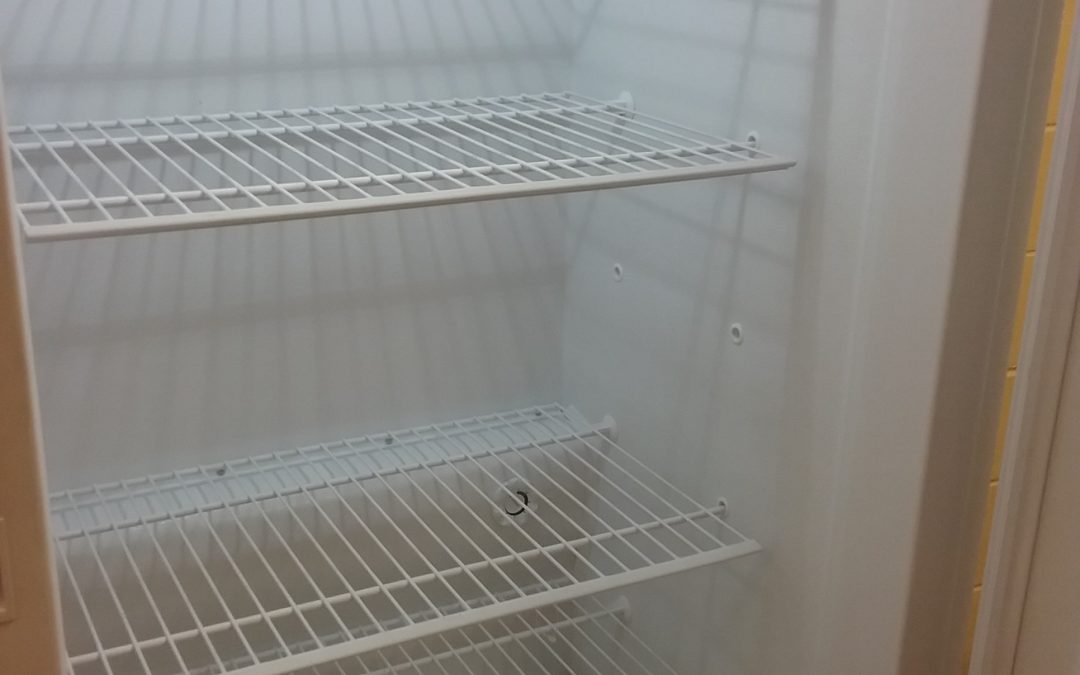
by Judy Corbus | Nov 15, 2018

Photo source: UF/IFAS Northwest District
After an extended power outage, your refrigerator and freezer may develop unpleasant odors from spoiled food. To get rid of these odors, remove all food items and clean the inside, including drawers and bins, with a mild cleaning solution of dish soap and water. You also can use a solution of 2 tablespoons baking soda and 4 cups warm water. Strong cleansers may affect the taste of food or ice cubes or damage the interior finish. Rinse with a bleach solution of one tablespoon unscented chlorine bleach per gallon of water to sanitize. Lemon juice and water solutions are not strong enough to sanitize effectively. Leave the unit unplugged with the door open for 1-2 days to air out. Spray disinfectant around hinges, locks, and into any openings.
If odors persist, try one of these methods:
- Spread activated charcoal, clean cat litter, or baking soda on trays and place on refrigerator or freezer shelves. Activated charcoal is extra dry and absorbs odors more quickly than cooking-type charcoal. It is available at drug or pet supply stores. Run the appliance empty for 2-3 days. If the odor remains, replace with new charcoal and repeat.
- Place trays of freshly ground coffee on appliance shelves and close the door. Run the appliance empty for 2-3 days. If a slight coffee aroma remains, wash and rinse shelves and the aroma should dissipate.
- Pack each shelf with crumpled newspaper. Set a cup of water on the top shelf or sprinkle the newspaper with water. Allow appliance to run for approximately 5-6 days. While this method is time-consuming, it is effective in removing strong odors.
- Use a commercial product designed for refrigerator and freezer odor removal. These products are available at hardware, grocery, discount, and variety stores.
Once the odor is gone, rinse and dry the appliance. Don’t forget to clean gaskets with a mild cleaning solution and warm water; rinse and dry. Dirt and spills can prevent the gasket from sealing well, resulting in a loss of cold air and higher utility bills. Also, clean the coils and front grill with a brush or vacuum cleaner to remove dirt that can hinder air flow to the condenser.
Use an appliance thermometer to check the temperature of your refrigerator and freezer. The refrigerator should be between 33˚F and 40˚F and the freezer at 0 degrees or below.
If there is still an odor after trying these steps, it is possible meat or fish drippings have seeped into the insulation. An appliance service technician may need to remove the liner and replace the insulation or the appliance may need to be replaced.
Sources:
My Florida Home Book – University of Florida/IFAS Extension
Solving Odor Problems in Your Refrigerator or Freezer – University of Nebraska-Lincoln Cooperative Extension
When the Power Goes Off – Clemson Cooperative Extension
Cleaning the Fridge – North Carolina State University Cooperative Extension

by Angela Hinkle | Nov 13, 2018

FCS Dine In Day December 3
Uncle Eddie wasn’t actually my uncle. He was my grandfather. But to most everyone in the small town in Connecticut where I spent many summers growing up, he was known as Uncle Eddie.
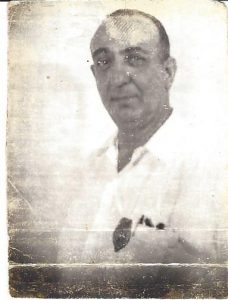
Edward Scordato aka “Uncle Eddie”
Every Saturday morning, Uncle Eddie got up at some ridiculously early hour and headed for the kitchen. He started a pot of coffee as well as a kettle for tea. He began making pancakes, toast, bacon or sausage, and eggs prepared in a variety of ways. (I think he honed his kitchen/organizational skills as a cook in the Army.)
Friends, neighbors, and relatives from all around came to my grandparents’ dining room and back patio to eat. Just as important, they came to socialize, catch up on how everyone was doing, and hear the latest personal and public events of the week. There was a little gossip and lots of talk of religion and politics. (As a kid, those last two subjects bored me like nothing else could.)
Some folks stayed for 20 minutes. Some stuck around for the whole morning. Uncle Eddie made sure everyone who came got fed. And not just food for their tummies. They were fed with family bonding, love, and a strong sense of belonging (and religion and politics).
Those Saturday morning breakfasts are some of my fondest memories. I honestly don’t remember the taste of the food, but I do remember it just felt good to be with everybody.
December 3rd is Dine In Day.
It’s a chance to make a commitment to have a meal at home with family. Research tells us families are healthier in so many ways when they eat at home together. So, make the decision to eat with your family at home this December 3rd. I’m going to. And it will even be okay if my family starts talking religion and politics.
Oh, and one more thing. Some of our family at UF/IFAS Extension will be sharing their favorite family meals very soon. Maybe you can tell us about yours. Maybe you can be inspired to make new ones.

by Angela Hinkle | Oct 28, 2018
You want to help but don’t know how? Maybe you don’t have much money and you don’t have skills, time, or transportation to get to hurricane Michael victims for clean up or rebuild. One easy, low-cost way to help is peanut butter.
Yes, peanut butter helps hurricane victims
Peanut butter tastes good. It is safe at room temperature – no need to refrigerate or heat. Great when there is no electricity. And it’s super easy. Spread on bread or nosh on a spoonful.
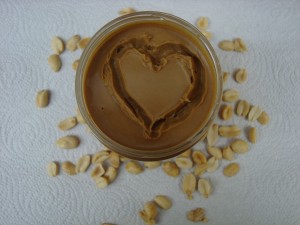
Nutty for Peanut Butter
Photo Source: Angela Hinkle
“I am so hungry. What are we going to eat?”
These words were repeated throughout affected areas of the Florida panhandle after the Michael disaster ripped through towns. Peanut butter was the answer for many. A great filler upper loaded with important protein.
The Peanut Butter Challenge
During the months of October and November, UF/IFAS Extension offices in the Florida panhandle are collecting peanut butter for the Peanut Butter Challenge. Peanut butter is dropped off at collection sites by gracious donors – like you. Then at the beginning of December, the peanut butter is distributed to hungry families in need at local food pantries. Because so many of our family, neighbors, and friends were affected by hurricane Michael, much of this peanut butter will also be headed to them this year.
Peanut Proud
Peanut Proud and others have already donated 36,000 jars of peanut butter to affected areas. While many jars will be “spread” throughout all Florida panhandle county pantries, much peanut butter will be distributed to hurricane Michael affected areas.
Gift Cards
Looking for other ways to help. Gift cards to Home Depot, Lowes, Ace, Walmart, etc. are greatly appreciated. These cards allow people to get what they need. No guesswork involved.
To find out how and where to donate as well additional recovery information, contact your local Northwest District UF/IFAS Extension office. University of Florida IFAS directory
by Samantha Kennedy | Oct 16, 2018
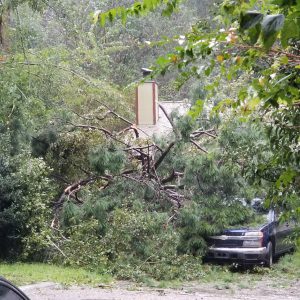
Downed trees and other debris should be handled carefully. Use proper equipment and follow all safety precautions to avoid injury. (Photo source: Samantha Kennedy)
Hurricane Michael was a storm of historic proportions, slamming into the Florida Panhandle and wreaking havoc on millions of people across the Big Bend region. Now that the storm has passed, the recovery phase has begun. Damage assessment, debris removal, structural repairs, and food safety concerns are just a few aspects of storm recovery, as people seek to rebuild their lives and return to a sense of normalcy.
There are a lot of things to think about after a disaster and it can be overwhelming. The first priority should always be basic necessities: food, water, and shelter. Make sure any structure is safe enough for habitation. If the structure’s integrity is compromised, seek alternate living arrangements.
Heed all boil water notices, if applicable. If boiling water is not possible, stick to using clean, bottled water for drinking, food preparation, and personal hygiene. Do not assume that because the food in the refrigerator is cool to the touch, that it is safe to eat. Perishable food must be kept at or below 40 degrees Fahrenheit to be considered safe. If it is uncertain as to whether that temperature was maintained while the power was out, the food should be discarded. Discard any perishable food from refrigerators after a power outage longer than 4 hours.
Be careful when assessing damage after the storm. Wear sturdy shoes and avoid wading through floodwaters. Wear a hat, sunglasses, and sunscreen when out in the sun. Drink plenty of clean water and maintain energy levels with small, nutrient-dense meals and snacks. Damaged tree limbs may continue to fall after the storm, so take heed of potential falling debris. Standing water can harbor snakes, fire ants, and other potentially dangerous critters, so take proper precautions at or around puddles or floodwater.
Use tools such as chainsaws and generators correctly and practice proper safety precautions. Do not run a generator inside and store gas cans a safe distance from both the generator and the living space. Allow others more skilled with using a chainsaw to help with debris collection and removal. If dealing with large amounts of mold, be sure to wear protective clothing and the proper respiratory mask to avoid contact with spores.
Unfortunately, many dishonest people take advantage of situations such as natural disasters to prey on those in need. Beware of people offering to help with repairs quickly and/or for an extraordinarily low price. Only hire reputable licensed contractors, even if that means having to wait for services. The Florida Department of Business and Professional Regulation myfloridalicense.com maintains a list of licensed contractors in the state of Florida. The Better Business Bureau provides ratings for a variety of businesses, including contractors. Use these resources as a guide to finding the right contractor.
Contact insurance companies as soon as possible after the storm to get the claims process rolling. Have the policy on hand when the call is made to make the process easier. It would be helpful to document any damage and have those photos available to share with the insurance agent or claims adjuster. Post-disaster is an extremely busy time for insurance companies, so be as cooperative and patient as possible during the process.
Disaster recovery is a very stressful time for everyone, often leading to confusion, anger, and helplessness. Reach out to existing support systems such as family, friends, churches, or other groups for emotional support. Practice self-care, such as regular meals and breaks. Establish a new normal routine and stick to it, especially for children. Most importantly, be kind to yourself and others during this difficult time.
The University of Florida IFAS Extension Service is a local resource for post-disaster education and assistance. More information about each of these topics and more can be provided by your local extension office.
The UF/IFAS Disaster Preparation & Recovery blog is a comprehensive resource to help with disaster recovery: http://disaster.ifas.ufl.edu/.
Extension classes are open to everyone regardless of race, creed, color, religion, age, disability, sex, sexual orientation, marital status, national origin, political opinions or affiliations.

by Angela Hinkle | Oct 9, 2018

Peanut Butter Challenge
Photo Source: UF/IFAS Extension Escambia
What would you do with 10,000 pounds of Peanut Butter? How about change the lives of hungry families.
What’s It All About?
The annual Peanut Butter Challenge has begun for 2018. Unopened jars of peanut butter are collected throughout the Florida Panhandle. We do this until the Tuesday before Thanksgiving at area Peanut Butter Challenge donation drop-off sites. Local peanut farmers help to match contributions. The peanut butter is then donated to local food pantries and food banks to help struggling families. Last year, the Peanut Butter Challenge collected about 9,000 pounds of peanut butter. This year, the goal is to collect 10,000 pounds of Peanut Butter. Five tons – whew, that’s a lot!
Why Is It Important?
When families are not sure where and when they will get healthy food to eat, they are considered to be food insecure. Many of these families rely on food pantries to supplement their dietary needs. Peanut butter is the most requested food in most pantries. It is loaded with protein and other good-for-you nutrients like fiber and potassium. Peanut butter is shelf stable – no need to heat or keep cold. Most people really like the taste of it. So…basically, a super food.
What is the Easiest Way for Me to Help?

Nutty for Peanut Butter
Photo Source: Angela Hinkle
Though peanut butter is very economical, (usually about $2.50 per pound), look at the sales ads. Almost every week, some place has peanut butter on sale. Better yet, look for the buy one, get one free specials. Keep one jar for yourself and donate a jar. Then take your peanut butter to the closest Peanut Butter Challenge collection site.
Where Can I Contribute or Find Out More?
To find out where to donate unopened jars of peanut butter in your area, contact your local Northwest District UF/IFAS Extension office.
Help UF/IFAS Extension and the Peanut Butter Challenge donate 10,000 pounds of peanut butter to help take a bite out of hunger for local families in need. Oh, and we’ll do the heavy lifting.
For more information on how UF/IFAS Extension faculty are working to provide food access to more people and stem this tide of hunger, read Nick Place on 2018 PBC.










